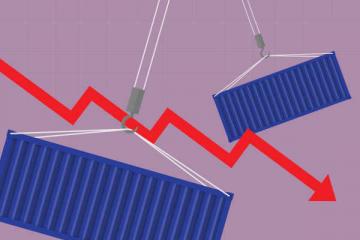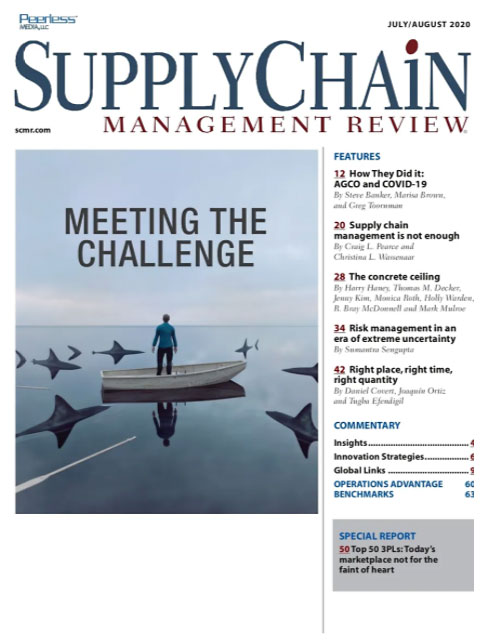Sorry, but your login has failed. Please recheck your login information and resubmit. If your subscription has expired, renew here.
July-August 2020
Supply chains have been in the news a lot the last couple of months, and not always for the right reasons. It seems as if the two words most often associated with supply chains these days are broken or failed, and supply chain is used to explain the shortages of everything from toilet paper to rib-eye steaks to personal protection equipment. Pundits question whether Amazon’s inability to make good on same-day and next-day deliveries or keep its endless shelves stocked during a pandemic will cost it market share. Browse this issue archive.Need Help? Contact customer service 847-559-7581 More options
What’s more, the problem is growing. Consider this: When the first Congress convened in 1790, there were only three federal criminal laws on the books: piracy, counterfeiting and treason. Today, that number exceeds 5,000, and that number doesn’t include over 300,000 federal criminal regulations. Enforcing them has led to an explosion of incarcerations: While the United States is home to only 4% of the world’s population, we are home to 25% of the world’s prison population. Today, an estimated one in three individuals has a criminal record. In fact, more people in this country have a criminal record than a college degree. What’s more, over 700,000 individuals are released from prison every year after they have completed their sentences and return home to their families and communities. Given the sheer numbers, the sad reality is that individuals with a criminal record aren’t hard to find: They are your neighbor, the parent of your children’s friends at school and the stranger in the back pew of your house of worship.
Recidivism rates are staggering, with more than 75% of those 700,000 are re-arrested, and likely returning to prison, within five years of their release. The light at the end of the tunnel is that for those who find a job within one year, the recidivism rate drops to just 7%. “We know that good, steady employment reduces the likelihood of an individual re-offending,” Thomas Dart, the sheriff of Cook County, Illinois, which includes Chicago, has stated, “which is why we offer job training and job readiness programs to our detainees in order to help them end the cycle of incarceration.” When a job is further complemented by wraparound services that help with housing, mental health and substance abuse treatment, the odds of a successful reentry continue to improve.
The concrete ceiling
So far, so good, right? Especially in the context of the supply chain, which, at least until COVID-19, was experiencing 100% annual turnover in positions in industrial facilities, at ports and shipping locations and in the trucking industry. And, of course, supply chain was not alone in experiencing a shortage of willing and loyal associates. Yet, individuals with criminal records face barriers to resources that are essential to daily living, such as access to housing, education, health care and others. That lack of access creates the virtual concrete ceiling when it comes to finding a job that can seem as oppressive as the physical walls of a prison.
“For many people leaving prison, the majority of whom are poor people of color returning to socially isolated, under-resourced communities, re-entry is more accurately described as ‘a temporary position between freedom and re-commitment’ to state custody,” the researchers Alfred Blumstein and Allen J. Beck have written. It is a vicious cycle that wastes lives, drains state and federal budgets and creates an environment that makes our society less safe.
The lack of resources is exacerbated by states budgets that are overburdened by the rising costs of incarceration, often outspending public education budgets at a rate of nearly two to one. Annually, our country loses nearly $57 billion in gross domestic product these individuals could have contributed to the economy, to say nothing of the downstream effects of incarceration on the family unit. Children with an incarcerated parent are two-thirds more likely to become justice-involved at some point in their own lives, beginning—or continuing—a generational cycle of offenders. The system, as it currently exists, benefits no one. Simply put, the denial of the opportunity to work will result in a continuous cycle of release and re-incarceration that will drain our communities of resources and make our streets less safe.
This is where business can play an integral role.

This complete article is available to subscribers only.
Log in now for full access or start your PLUS+ subscription for instant access.
SC
MR
Sorry, but your login has failed. Please recheck your login information and resubmit. If your subscription has expired, renew here.
July-August 2020
Supply chains have been in the news a lot the last couple of months, and not always for the right reasons. It seems as if the two words most often associated with supply chains these days are broken or failed, and… Browse this issue archive. Access your online digital edition. Download a PDF file of the July-August 2020 issue.What’s more, the problem is growing. Consider this: When the first Congress convened in 1790, there were only three federal criminal laws on the books: piracy, counterfeiting and treason. Today, that number exceeds 5,000, and that number doesn’t include over 300,000 federal criminal regulations. Enforcing them has led to an explosion of incarcerations: While the United States is home to only 4% of the world’s population, we are home to 25% of the world’s prison population. Today, an estimated one in three individuals has a criminal record. In fact, more people in this country have a criminal record than a college degree. What’s more, over 700,000 individuals are released from prison every year after they have completed their sentences and return home to their families and communities. Given the sheer numbers, the sad reality is that individuals with a criminal record aren’t hard to find: They are your neighbor, the parent of your children’s friends at school and the stranger in the back pew of your house of worship.
Recidivism rates are staggering, with more than 75% of those 700,000 are re-arrested, and likely returning to prison, within five years of their release. The light at the end of the tunnel is that for those who find a job within one year, the recidivism rate drops to just 7%. “We know that good, steady employment reduces the likelihood of an individual re-offending,” Thomas Dart, the sheriff of Cook County, Illinois, which includes Chicago, has stated, “which is why we offer job training and job readiness programs to our detainees in order to help them end the cycle of incarceration.” When a job is further complemented by wraparound services that help with housing, mental health and substance abuse treatment, the odds of a successful reentry continue to improve.
The concrete ceiling
So far, so good, right? Especially in the context of the supply chain, which, at least until COVID-19, was experiencing 100% annual turnover in positions in industrial facilities, at ports and shipping locations and in the trucking industry. And, of course, supply chain was not alone in experiencing a shortage of willing and loyal associates. Yet, individuals with criminal records face barriers to resources that are essential to daily living, such as access to housing, education, health care and others. That lack of access creates the virtual concrete ceiling when it comes to finding a job that can seem as oppressive as the physical walls of a prison.
“For many people leaving prison, the majority of whom are poor people of color returning to socially isolated, under-resourced communities, re-entry is more accurately described as ‘a temporary position between freedom and re-commitment’ to state custody,” the researchers Alfred Blumstein and Allen J. Beck have written. It is a vicious cycle that wastes lives, drains state and federal budgets and creates an environment that makes our society less safe.
The lack of resources is exacerbated by states budgets that are overburdened by the rising costs of incarceration, often outspending public education budgets at a rate of nearly two to one. Annually, our country loses nearly $57 billion in gross domestic product these individuals could have contributed to the economy, to say nothing of the downstream effects of incarceration on the family unit. Children with an incarcerated parent are two-thirds more likely to become justice-involved at some point in their own lives, beginning—or continuing—a generational cycle of offenders. The system, as it currently exists, benefits no one. Simply put, the denial of the opportunity to work will result in a continuous cycle of release and re-incarceration that will drain our communities of resources and make our streets less safe.
This is where business can play an integral role.
SC
MR


Latest Supply Chain News
Latest Podcast
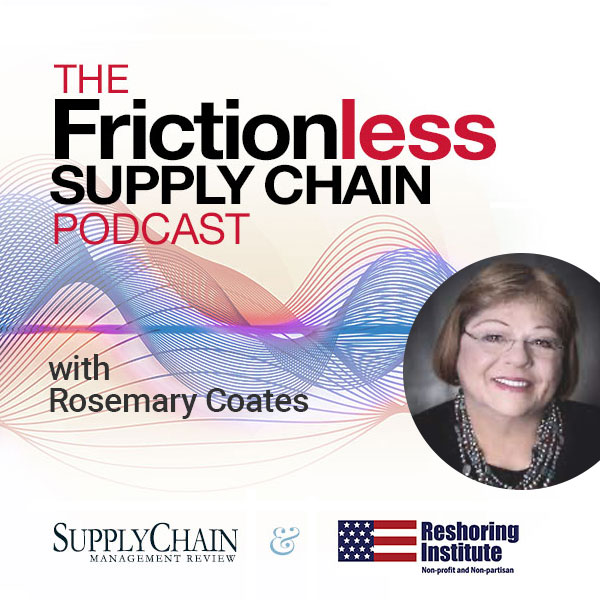
 Explore
Explore
Business Management News
- Strategic cost savings differ from cutting costs
- Planning fatigue may be settling in
- Inflation, economic worries among top supply chain concerns for SMBs
- April Services PMI declines following 15 months of growth, reports ISM
- Attacking stubborn COGS inflation with Digital Design-and-Source-to-Value
- Joseph Esteves named CEO of SGS Maine Pointe
- More Business Management
Latest Business Management Resources
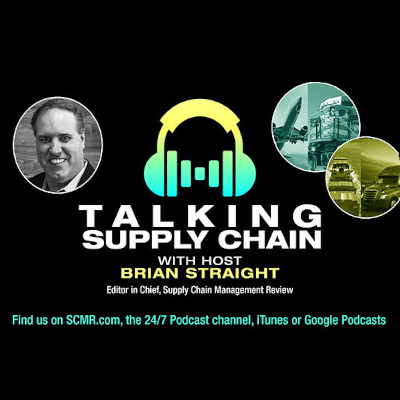
Subscribe
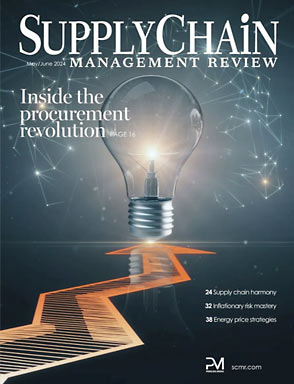
Supply Chain Management Review delivers the best industry content.

Editors’ Picks


